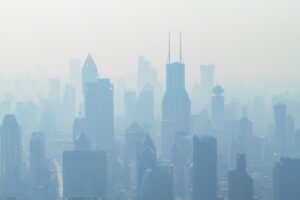By Pooja JAIN, PhD and Research Fellow at Asia Centre.
Introduction
A crucial goal of India’s Nationally Determined Contribution (NDC 2015) is to reduce the emissions intensity of its GDP by 33 to 35 per cent by 2030 from 2005 level. India is very much on course to achieve this goal. The Third Biennial Update Report 2021 by the Indian Ministry of Environment, Forest and Climate Change (MOEFCC) points out that India’s emissions intensity of GDP has reduced by 24 per cent between 2004 and 2016, achieving the target of reducing emissions intensity of GDP by 25 per cent by 2020.
The United Nations Emissions Gap Report 2020 states that India is projected to meet its NDC targets. It says that the decrease in India’s emission projections for 2030 would be partly due to an increase in the use of renewable energy. The report cites two studies Climate Action Tracker 2020 and International Energy Agency (IEA) 2020 indicating that India may see larger reductions by 2030 compared with other major emitters.
As things stand, the probability of the above scenario is getting higher with and without planned government action. Like China, India has intensity targets. Its reduction targets are defined per unit of gross domestic product (GDP). Therefore, the impact of the pandemic on India’s GDP will directly affect its carbon emissions. According to the Pew Research Centre, the pandemic has caused 32 million people in India to slip into poverty making up the majority of the 54 million people worldwide who slipped out of the middle class. In the near future, both the emissions intensity and per capita emissions are likely to fall in view of the economic downturn caused by a devastating second wave of the pandemic. The possibility of a third wave cannot be ruled out either.
India isn’t likely to emerge from the pandemic by November 2021 given the paucity of vaccines and the sheer amount of time that is needed to vaccinate its huge population. The second wave of the pandemic saw India reversing its policy on foreign aid that it had stopped accepting since the tsunami in 2004. The calls for finance and technology transfer from developed countries will only grow louder at Glasgow for the 26th United Nations Climate Change Conference for the Parties (COP26).
However, given the glaring uncertainty in which the country finds itself, India would not be pressed upon to issue time-bound targets that are compatible with limiting the rise in global warming to 1.5 degrees C above pre-industrial levels. India’s current NDC is compatible with restricting the warming to not more than 2 degrees. It hasn’t submitted a renewed NDC yet. It is also most likely that India would still not be in the position to announce its emissions peaking year.
In light of the above arguments, this paper embarks on a multipronged analysis to understand India’s approach to climate change. The paper will draw on a varied set of variables, namely: negotiating principles, strategic engagement, domestic demand for climate action and personal inclinations of its larger than life Prime Minister. I will analyse how and why these variables allow predict India’s position on climate change. The paper makes the case for the study for leadership and political economy incentives as decisive factors in predicting action on climate change.





